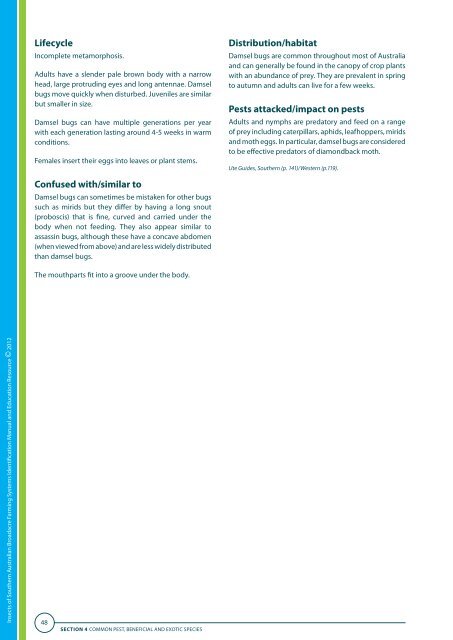Insects of Southern Australian Broadacre Farming Systems - Grains ...
Insects of Southern Australian Broadacre Farming Systems - Grains ...
Insects of Southern Australian Broadacre Farming Systems - Grains ...
Create successful ePaper yourself
Turn your PDF publications into a flip-book with our unique Google optimized e-Paper software.
Lifecycle<br />
Incomplete metamorphosis.<br />
Adults have a slender pale brown body with a narrow<br />
head, large protruding eyes and long antennae. Damsel<br />
bugs move quickly when disturbed. Juveniles are similar<br />
but smaller in size.<br />
Damsel bugs can have multiple generations per year<br />
with each generation lasting around 4-5 weeks in warm<br />
conditions.<br />
Females insert their eggs into leaves or plant stems.<br />
Distribution/habitat<br />
Damsel bugs are common throughout most <strong>of</strong> Australia<br />
and can generally be found in the canopy <strong>of</strong> crop plants<br />
with an abundance <strong>of</strong> prey. They are prevalent in spring<br />
to autumn and adults can live for a few weeks.<br />
Pests attacked/impact on pests<br />
Adults and nymphs are predatory and feed on a range<br />
<strong>of</strong> prey including caterpillars, aphids, leafhoppers, mirids<br />
and moth eggs. In particular, damsel bugs are considered<br />
to be effective predators <strong>of</strong> diamondback moth.<br />
Ute Guides, <strong>Southern</strong> (p. 141)/Western (p.119).<br />
Confused with/similar to<br />
Damsel bugs can sometimes be mistaken for other bugs<br />
such as mirids but they differ by having a long snout<br />
(proboscis) that is fine, curved and carried under the<br />
body when not feeding. They also appear similar to<br />
assassin bugs, although these have a concave abdomen<br />
(when viewed from above) and are less widely distributed<br />
than damsel bugs.<br />
The mouthparts fit into a groove under the body.<br />
<strong>Insects</strong> <strong>of</strong> <strong>Southern</strong> <strong>Australian</strong> <strong>Broadacre</strong> <strong>Farming</strong> <strong>Systems</strong> Identification Manual and Education Resource © 2012<br />
48<br />
SECTION 4 COMMON Pest, Beneficial and exotic Species

















